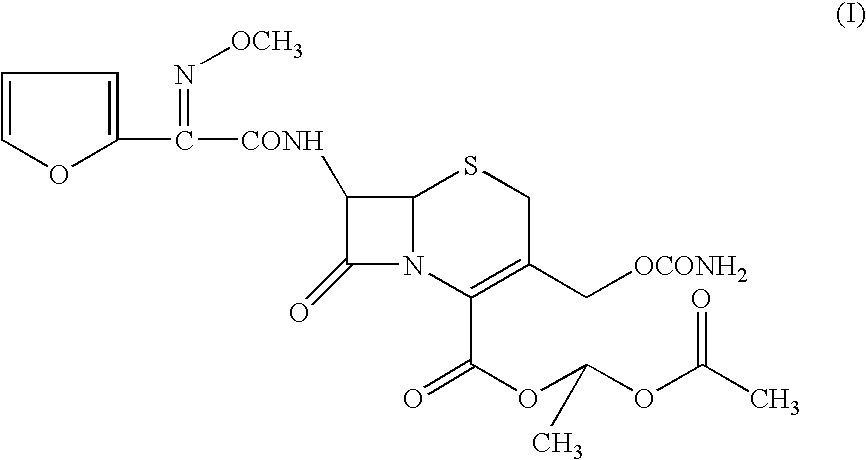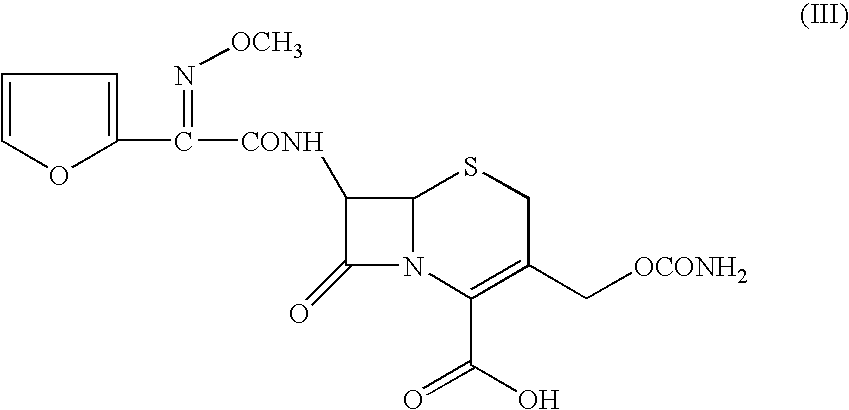Method for preparation of cefuroxime axetil
- Summary
- Abstract
- Description
- Claims
- Application Information
AI Technical Summary
Benefits of technology
Problems solved by technology
Method used
Image
Examples
example-1
Preparation of (R,S-1-Acetoxyethyl-3-carbamoyloxymethyl-7-[(Z)-2-(fur-2-yl)-2-methoxyiminoacetamido]ceph-3-em-4-carboxylate (Cefuroxime axetil, I): Without use of Group I / II metal phosphate and C1-4 alcohol
[0092](R,S)-1-Acetoxyethyl bromide (1.6 gms; 0.0094 moles) was added to a mixture of cefuroxime acid (2 gms; 0.0047 moles) and potassium carbonate (0.326 gms; 0.00235 moles) in N,N-dimethylacetamide (10 ml) at 5° C. and stirred at 0 to 20° C. for 180 minutes. Ethyl acetate was added to the reaction mixture, followed by 3% aqueous sodium bicarbonate solution (15 ml). The organic layer containing the title product, Δ2 isomer (8.51%) and unidentified impurities (X1—1.86% and X2—3.54%) was separated and washed with 10% aqueous NaCl solution. The organic solvent was evaporated off under vacuum to give 1.08 gms (44.90%) of the title compound as a gummy solid.
[0093]HPLC analysis: Purity (compound I)—89.11%; Impurities: Δ2 isomer (II)—8.51%, X1—1.86% and X2—3.54%
example-2
Preparation of (R,S-1-Acetoxyethyl-3-carbamoyloxymethyl-7-[(Z)-2-(fur-2-yl)-2-methoxyiminoacetamido]ceph-3-em-4-carboxylate (Cefuroxime axetil, I): in presence of disodium hydrogen phosphate and methanol
[0094](R,S)-1-Acetoxyethyl bromide (3.94 gms; 0.0235 moles) pre-mixed with methanol (0.15 gms; 0.0047 moles) was added to a stirred mixture of cefuroxime acid (5 gms; 0.0118 moles), sodium carbonate (0.94 gms; 0.0088 moles) and disodium hydrogen phosphate (1.0 gms; 0.007 moles) in N,N-dimethylacetamide (20 ml) at 0° C. The mixture was stirred at 0 to 20° C. for 180 minutes. Ethyl acetate was added to the reaction mixture, followed by 3% aqueous sodium bicarbonate solution (25 ml). The organic layer was separated and washed with 10% aqueous sodium chloride solution. The organic extract was stirred with activated charcoal (0.5 gms) for 30 minutes and filtered through a celite bed. The organic layer was evaporated under vacuum and the solid obtained crystallised from a mixture of ethyl ...
example-3
Preparation of (R,S-1-Acetoxyethyl-3-carbamoyloxymethyl-7-[(Z)-2-(fur-2-yl)-2-methoxyiminoacetamido]ceph-3-em-4-carboxylate (Cefuroxime axetil, I): in presence of sodium dihydrogen phosphate and ethanol
[0099](R,S)-1-Acetoxyethyl bromide (3.94 gms; 0.0235 moles) pre-mixed with ethanol (0.434 gms; 0.0090 moles) was added to a stirred mixture of cefuroxime acid (5 gms; 0.0118 moles), sodium carbonate (1.0 gms; 0.0090 moles) and sodium dihydrogen phosphate (0.21 gms; 0.0017 moles) in N,N-dimethylacetamide (20 ml) at 0–5° C. The mixture was stirred at 0 to 20° C. for 180 minutes. Ethyl acetate was added to the reaction mixture, followed by 3% aqueous sodium bicarbonate solution (25 ml). The organic layer was separated and washed with 10% aqueous sodium chloride solution. The organic extract was stirred with activated charcoal (0.5 gms) for 30 minutes and filtered through a celite bed. The organic layer was evaporated under vacuum and the solid obtained crystallised from a mixture of ethy...
PUM
| Property | Measurement | Unit |
|---|---|---|
| Temperature | aaaaa | aaaaa |
| Temperature | aaaaa | aaaaa |
| Fraction | aaaaa | aaaaa |
Abstract
Description
Claims
Application Information
 Login to View More
Login to View More - R&D
- Intellectual Property
- Life Sciences
- Materials
- Tech Scout
- Unparalleled Data Quality
- Higher Quality Content
- 60% Fewer Hallucinations
Browse by: Latest US Patents, China's latest patents, Technical Efficacy Thesaurus, Application Domain, Technology Topic, Popular Technical Reports.
© 2025 PatSnap. All rights reserved.Legal|Privacy policy|Modern Slavery Act Transparency Statement|Sitemap|About US| Contact US: help@patsnap.com



